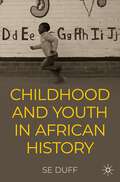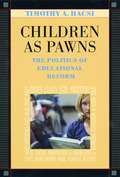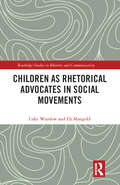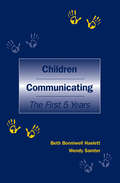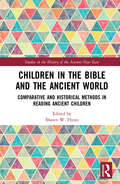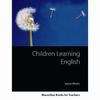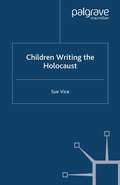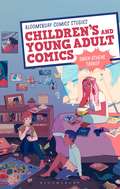- Table View
- List View
Children and Youth in African History
by SE DuffThis textbook introduces readers to the academic scholarship on the history of childhood and youth in sub-Saharan Africa, with a particular focus on the colonial and postcolonial eras. In a series of seven chapters, it addresses key themes in the historical scholarship, arguing that age serves as a useful category for historical analysis in African history. Just as race, class, and gender can be used to understand how African societies have been structured over time, so too age is a powerful tool for thinking about how power, youth, and seniority intersect and change over time. This is, then, a work of synthesis rather than of new research based on primary sources. This book will therefore introduce mainstream scholars of the history of childhood and youth to the literature on Africa, and scholars of youth in Africa to debates within the wider field of the history of children and youth.
Children as Pawns: The Politics of Educational Reform
by Timothy A. HacsiHead Start. Bilingual education. Small class size. Social promotion. School funding. Virtually every school system in America has had to face these issues over the past thirty years. Advocates and dissenters have declared confidently that "the research" is on their side. But is it? In the first book to bring together the recent history of educational policy and politics with the research evidence, Timothy Hacsi presents the illuminating, often-forgotten stories of these five controversial topics. He sifts through the complicated evaluation research literature and compares the policies that have been adopted to the best evidence about what actually works. He lucidly explains what the major studies show, what they don't, and how they have been misunderstood and misrepresented. Hacsi shows how rarely educational policies are based on solid research evidence, and how programs that sound plausible simply do not satisfy the complex needs of real children.
Children as Rhetorical Advocates in Social Movements (Routledge Studies in Rhetoric and Communication)
by Luke Winslow Eli MangoldThis book examines “Rhetorical Children” as visible and vocal communicators, shaping public discourse on contentious social issues related to organized labor, civil rights, gun violence, and climate change. This book explores four key social movement case studies: the 1903 Mother Jones-led March of the Mill Children to reform child labor laws, the 1963 Dr. Martin Luther King, Jr.,-led Children’s Crusade to end segregation, the 2018 Parkland student-led March for Our Lives movement to end gun violence, and the ongoing struggle for climate change mitigation led by Swedish activist Greta Thunberg. Through these case studies, the book outlines three rhetorical strategies, namely children’s ability to activate adults’ moral obligation; to invoke threats to natality and lost childhood; and to disrupt social order. It enables readers to better understand rhetorical children and the rhetorical tools required for social movements. Assessing the powerful role children play in shaping public discourse, this book will be of interest to students and scholars in the fields of Communication Studies, Rhetoric, Public Address, Social Movements, and Cultural Studies.
Children as Rhetorical Advocates in Social Movements (Routledge Studies in Rhetoric and Communication)
by Luke Winslow Eli MangoldThis book examines “Rhetorical Children” as visible and vocal communicators, shaping public discourse on contentious social issues related to organized labor, civil rights, gun violence, and climate change. This book explores four key social movement case studies: the 1903 Mother Jones-led March of the Mill Children to reform child labor laws, the 1963 Dr. Martin Luther King, Jr.,-led Children’s Crusade to end segregation, the 2018 Parkland student-led March for Our Lives movement to end gun violence, and the ongoing struggle for climate change mitigation led by Swedish activist Greta Thunberg. Through these case studies, the book outlines three rhetorical strategies, namely children’s ability to activate adults’ moral obligation; to invoke threats to natality and lost childhood; and to disrupt social order. It enables readers to better understand rhetorical children and the rhetorical tools required for social movements. Assessing the powerful role children play in shaping public discourse, this book will be of interest to students and scholars in the fields of Communication Studies, Rhetoric, Public Address, Social Movements, and Cultural Studies.
Children at War: From The First World War To The Gulf (Contemporary Classics in Children's Literature)
by Kate Agnew Geoff FoxThis book provides a critical appraisal of the treatment of war in children's reading during the 20th century, covering World War I, World War II and subsequent wars, including Vietnam, the Gulf War and the war in the Balkans.
Children Communicating: The First 5 Years
by Wendy Samter Beth Bonniwell HaslettOffering a unique focus on the development of human communication, this book integrates and synthesizes a more comprehensive array of research than most investigations of communicative development. As such, it incorporates materials dealing with the development of nonverbal communication, language, and cognition, and examines how they are integrated in the growing child's everyday interaction. This information is distilled into a set of key principles and practices--culled from a variety of fields including developmental and social psychology, sociolinguistics, psycholinguistics, and communication--for parents or adults interested in child development. While this book does not offer an in-depth view in any one area, it provides a comprehensive overview of the various components of human communicative development and its significance for the child's cognitive and emotional growth. It is quite clear that developmental processes are constrained by multiple influences whose interactions have just begun to be uncovered. Examining the diverse facets of communicative development will enable professionals to garner further insights into the mystery of human communication.
Children Communicating: The First 5 Years (Routledge Communication Ser.)
by Wendy Samter Beth Bonniwell HaslettOffering a unique focus on the development of human communication, this book integrates and synthesizes a more comprehensive array of research than most investigations of communicative development. As such, it incorporates materials dealing with the development of nonverbal communication, language, and cognition, and examines how they are integrated in the growing child's everyday interaction. This information is distilled into a set of key principles and practices--culled from a variety of fields including developmental and social psychology, sociolinguistics, psycholinguistics, and communication--for parents or adults interested in child development. While this book does not offer an in-depth view in any one area, it provides a comprehensive overview of the various components of human communicative development and its significance for the child's cognitive and emotional growth. It is quite clear that developmental processes are constrained by multiple influences whose interactions have just begun to be uncovered. Examining the diverse facets of communicative development will enable professionals to garner further insights into the mystery of human communication.
Children in Culture: Approaches to Childhood
by Karin Lesnik-ObersteinChildren in Culture is one of the first fully multi- and interdisciplinary collections of essays on theoretical approaches to childhood and formulates and presents new and exciting ideas about the construction of childhood as a cultural identity. The ten original chapters have been written especially for this volume by some of the most eminent writers on childhood in their fields: psychology (Valerie Walkerdine; Rex and Wendy Stainton Rogers), history (Jenny Bourne Taylor; Kimberly Reynolds; Paul Yates), critical theory (Erica Burman), literary criticism (Margarida Morgado; Sara Thornton), children's literature criticism (Karin Lesnik-Oberstein; Stephen Thomson), and film and drama theory (Joe Kelleher).
Children in Culture, Revisited: Further Approaches to Childhood
by Karín Lesnik-ObersteinChildren in Culture, Revisited follows on from the first volume, Children in Culture , and is composed of a range of chapters, newly written for this collection, which offer further fully inter- and multidisciplinary considerations of childhood as a culturally and historically constructed identity rather than a constant psycho-biological entity.
Children in Greek Tragedy: Pathos and Potential
by Emma M. GriffithsAstyanax is thrown from the walls of Troy; Medeia kills her children as an act of vengeance against her husband; Aias reflects with sorrow on his son's inheritance, yet kills himself and leaves Eurysakes vulnerable to his enemies. The pathos created by threats to children is a notable feature of Greek tragedy, but does not in itself explain the broad range of situations in which the ancient playwrights chose to employ such threats. Rather than casting children in tragedy as simple figures of pathos, this volume proposes a new paradigm to understand their roles, emphasizing their dangerous potential as the future adults of myth. Although they are largely silent, passive figures on stage, children exert a dramatic force that transcends their limited physical presence, and are in fact theatrically complex creations who pose a danger to the major characters. Their multiple projected lives create dramatic palimpsests which are paradoxically more significant than their immediate emotional effects: children are never killed because of their immediate weakness, but because of their potential strength. This re-evaluation of the significance of child characters in Greek tragedy draws on a fresh examination of the evidence for child actors in fifth-century Athens, which concludes that the physical presence of children was a significant factor in their presentation. However, child roles can only be fully appreciated as theatrical phenomena, utilizing the inherent ambiguities of drama: as such, case studies of particular plays and playwrights are underpinned by detailed analysis of staging considerations, opening up new avenues for interpretation and challenging traditional models of children in tragedy.
Children in Greek Tragedy: Pathos and Potential
by Emma M. GriffithsAstyanax is thrown from the walls of Troy; Medeia kills her children as an act of vengeance against her husband; Aias reflects with sorrow on his son's inheritance, yet kills himself and leaves Eurysakes vulnerable to his enemies. The pathos created by threats to children is a notable feature of Greek tragedy, but does not in itself explain the broad range of situations in which the ancient playwrights chose to employ such threats. Rather than casting children in tragedy as simple figures of pathos, this volume proposes a new paradigm to understand their roles, emphasizing their dangerous potential as the future adults of myth. Although they are largely silent, passive figures on stage, children exert a dramatic force that transcends their limited physical presence, and are in fact theatrically complex creations who pose a danger to the major characters. Their multiple projected lives create dramatic palimpsests which are paradoxically more significant than their immediate emotional effects: children are never killed because of their immediate weakness, but because of their potential strength. This re-evaluation of the significance of child characters in Greek tragedy draws on a fresh examination of the evidence for child actors in fifth-century Athens, which concludes that the physical presence of children was a significant factor in their presentation. However, child roles can only be fully appreciated as theatrical phenomena, utilizing the inherent ambiguities of drama: as such, case studies of particular plays and playwrights are underpinned by detailed analysis of staging considerations, opening up new avenues for interpretation and challenging traditional models of children in tragedy.
Children in Immigrant Families Becoming Literate: A Window into Identity Construction, Transnationality, and Schooling
by Catherine Compton-Lilly Stephanie Shedrow Dana Hagerman Laura Hamman-Ortiz Yao-Kai Chi Jieun Kim Sun Young Lee Kristin Papoi Erin Quast Brooke Ward Taira Bingjie ZhengThis original book offers a meaningful window into the lived experiences of children from immigrant families, providing a holistic, profound portrait of their literacy practices as situated within social, cultural, and political frames. Drawing on reports from five years of an ongoing longitudinal research project involving students from immigrant families across their elementary school years, each chapter explores a unique set of questions about the students’ experiences and offers a rich data set of observations, interviews, and student-created artifacts. Authors apply different sociocultural, sociomaterial, and sociopolitical frameworks to better understand the dimensions of the children’s experiences. The multitude of approaches applied demonstrates how viewing the same data through distinct lenses is a powerful way to uncover the differences and comparative uses of these theories. Through such varied lenses, it becomes apparent how the complexities of lived experiences inform and improve our understanding of teaching and learning, and how our understanding of multifaceted literacy practices affects students’ social worlds and identities. Children in Immigrant Families Becoming Literate is a much-needed resource for scholars, professors, researchers, and graduate students in language and literacy education, English education, and teacher education.
Children in Immigrant Families Becoming Literate: A Window into Identity Construction, Transnationality, and Schooling
by Catherine Compton-Lilly Stephanie Shedrow Dana Hagerman Laura Hamman-Ortiz Yao-Kai Chi Jieun Kim Sun Young Lee Kristin Papoi Erin Quast Brooke Ward Taira Bingjie ZhengThis original book offers a meaningful window into the lived experiences of children from immigrant families, providing a holistic, profound portrait of their literacy practices as situated within social, cultural, and political frames. Drawing on reports from five years of an ongoing longitudinal research project involving students from immigrant families across their elementary school years, each chapter explores a unique set of questions about the students’ experiences and offers a rich data set of observations, interviews, and student-created artifacts. Authors apply different sociocultural, sociomaterial, and sociopolitical frameworks to better understand the dimensions of the children’s experiences. The multitude of approaches applied demonstrates how viewing the same data through distinct lenses is a powerful way to uncover the differences and comparative uses of these theories. Through such varied lenses, it becomes apparent how the complexities of lived experiences inform and improve our understanding of teaching and learning, and how our understanding of multifaceted literacy practices affects students’ social worlds and identities. Children in Immigrant Families Becoming Literate is a much-needed resource for scholars, professors, researchers, and graduate students in language and literacy education, English education, and teacher education.
Children in the Bible and the Ancient World: Comparative and Historical Methods in Reading Ancient Children (Studies in the History of the Ancient Near East)
by Shawn W. FlynnThe topic of children in the Bible has long been under-represented, but this has recently changed with the development of childhood studies in broader fields, and the work of several dedicated scholars. While many reading methods are employed in this emerging field, comparative work with children in the ancient world has been an important tool to understand the function of children in biblical texts. Children in the Bible and the Ancient World broadly introduces children in the ancient world, and specifically children in the Bible. It brings together an international group of experts who help readers understand how children are constructed in biblical literature across three broad areas: children in the Hebrew Bible and the Ancient Near East, children in Christian writings and the Greco-Roman world, and children and materiality. The diverse essays cover topics such as: vows in Ugarit and the Hebrew Bible, obstetric knowledge, infant abandonment, the role of marriage, Greek abandonment texts, ritual entry for children into Christian communities, education, sexual abuse, and the role of archeological figurines in children’s lives. The volume also includes expertise in biological anthropology to study the skeletal remains of ancient children, as well as how ancient texts illuminate Mary’s female maturity. The volume is written in an accessible style suitable for non-specialists, and it is equipped with a helpful resource bibliography that organizes select secondary sources from these essays into meaningful categories for further study. Children in the Bible and the Ancient World is a helpful introduction to any who study children and childhood in the ancient world. In addition, the volume will be of interest to experts who are engaged in historical approaches to biblical studies, while appreciating how the ancient world continues to illuminate select topics in biblical texts.
Children in the Bible and the Ancient World: Comparative and Historical Methods in Reading Ancient Children (Studies in the History of the Ancient Near East)
by Shawn W. FlynnThe topic of children in the Bible has long been under-represented, but this has recently changed with the development of childhood studies in broader fields, and the work of several dedicated scholars. While many reading methods are employed in this emerging field, comparative work with children in the ancient world has been an important tool to understand the function of children in biblical texts. Children in the Bible and the Ancient World broadly introduces children in the ancient world, and specifically children in the Bible. It brings together an international group of experts who help readers understand how children are constructed in biblical literature across three broad areas: children in the Hebrew Bible and the Ancient Near East, children in Christian writings and the Greco-Roman world, and children and materiality. The diverse essays cover topics such as: vows in Ugarit and the Hebrew Bible, obstetric knowledge, infant abandonment, the role of marriage, Greek abandonment texts, ritual entry for children into Christian communities, education, sexual abuse, and the role of archeological figurines in children’s lives. The volume also includes expertise in biological anthropology to study the skeletal remains of ancient children, as well as how ancient texts illuminate Mary’s female maturity. The volume is written in an accessible style suitable for non-specialists, and it is equipped with a helpful resource bibliography that organizes select secondary sources from these essays into meaningful categories for further study. Children in the Bible and the Ancient World is a helpful introduction to any who study children and childhood in the ancient world. In addition, the volume will be of interest to experts who are engaged in historical approaches to biblical studies, while appreciating how the ancient world continues to illuminate select topics in biblical texts.
Children Learning English (PDF)
by J. MoonChildren Learning English reveals the special features of teaching foreign languages to young learners. It is an inspiring read and a useful practical guide in a single volume.
Children Learning Second Languages (Research and Practice in Applied Linguistics)
by Annamaria PinterThis comprehensive guide to research and debate centres around language learning in childhood, the age factor and the different contexts where language learning happens, including home and school contexts. The scope is wide, capturing examples of studies with different age groups, different methodological approaches and different languages.
Children, Literacy and Ethnicity: Reading Identities in the Primary School
by Lexie SchererThis book explores children's meaning making of the books they learn to read with, especially relating to the intersections of race, gender and class. Based on research using a participative, innovative design with young children, issues of identity, belonging and classroom hierarchies are explored in complex and poignant ways by the children.
Children, Media, and Pandemic Parenting: Family Life in Uncertain Times (Routledge Studies in New Media and Cyberculture)
by Rebekah Willett Xinyu ZhaoThis book examines changes in families’ rules and routines connected with media during the pandemic and shifts in parents’ understanding of children’s media use.Drawing on interviews with 130 parents at the height of the COVID-19 pandemic, the book explores specific cultural contexts across seven countries: Australia, Canada, China, Colombia, South Korea, United Kingdom, and United States. Readers will gain an understanding of family media practices during the pandemic and how they were influenced by contextual factors such as the pandemic restrictions, family relationships and situations, socioeconomic statuses, cultural norms and values, and sociotechnical visions, among others. Further, encounter with theoretical framings will provide innovative ways to understand what it means for children, parents, and families to live in the digital age.This timely volume will offer key insights to researchers and graduate students studying in a variety of disciplines, including media and cultural studies, communication arts, education, childhood studies, and family studies.The Open Access version of this book, available at www.taylorfrancis.com, has been made available under a Creative Commons Attribution- Non Commercial- No Derivatives (CC- BY- NC- ND) 4.0 license.
Children, Media, and Pandemic Parenting: Family Life in Uncertain Times (Routledge Studies in New Media and Cyberculture)
This book examines changes in families’ rules and routines connected with media during the pandemic and shifts in parents’ understanding of children’s media use.Drawing on interviews with 130 parents at the height of the COVID-19 pandemic, the book explores specific cultural contexts across seven countries: Australia, Canada, China, Colombia, South Korea, United Kingdom, and United States. Readers will gain an understanding of family media practices during the pandemic and how they were influenced by contextual factors such as the pandemic restrictions, family relationships and situations, socioeconomic statuses, cultural norms and values, and sociotechnical visions, among others. Further, encounter with theoretical framings will provide innovative ways to understand what it means for children, parents, and families to live in the digital age.This timely volume will offer key insights to researchers and graduate students studying in a variety of disciplines, including media and cultural studies, communication arts, education, childhood studies, and family studies.The Open Access version of this book, available at www.taylorfrancis.com, has been made available under a Creative Commons Attribution- Non Commercial- No Derivatives (CC- BY- NC- ND) 4.0 license.
Children Of Silence: Studies in Contemporary Fiction
by Michael WoodIn this absorbing series of essays Michael Wood probes and plays with the dilemmas of twentieth century fiction - the myth of lost paradise, lost certainties, the suspension between contrary ideals, the lure of fantasy, the quest for the silence beneath speech. Wood's net is cast wide, from fables to novels, and he takes due account of personal and political context and of wider cultural and critical currents, noting fiction's swerving resistance to `history'. A superb essay on Roland Barthes is juxtaposed with a dissection of Beckett's prose comedy; an investigation of three Cuban writers -Cortazar, Cabrera Infante and Arenas - is followed by illuminating essays on Milan Kundera and Italo Calvino. In the second half of the book, the exploration of time, form and fantasy, and of the break with modernism, continues in studies of Garcia Marquez, Toni Morrison, Angela Carter, Kazuo Ishiguro, Salman Rushdie, Paul Auster and Jeanette Winterson. Rich with pleasures, spiked with insights, provocative and satisfying, this is one of the most exciting explorations of contemporary literature in recent years.
Children Writing Poems: Poetic Voices in and out of School (Routledge Research in Education #12)
by Janine CertoThis volume demonstrates how the social and instructional worlds that children inhabit influence their poetry writing and performances. Drawing on rich vignettes of students from different racial, ethnic and linguistic backgrounds, it describes and analyzes the work of eight to ten-year-old U.S. students involved in a month-long poetry unit. Children Writing Poems outlines the value of a ‘poetic-functional’ approach to help children convey a poem’s meaning and mood, and expresses the need for educators to scaffold children’s oral readings and performances over time.
Children Writing Poems: Poetic Voices in and out of School (Routledge Research in Education #12)
by Janine CertoThis volume demonstrates how the social and instructional worlds that children inhabit influence their poetry writing and performances. Drawing on rich vignettes of students from different racial, ethnic and linguistic backgrounds, it describes and analyzes the work of eight to ten-year-old U.S. students involved in a month-long poetry unit. Children Writing Poems outlines the value of a ‘poetic-functional’ approach to help children convey a poem’s meaning and mood, and expresses the need for educators to scaffold children’s oral readings and performances over time.
Children Writing the Holocaust
by S. ViceThis book examines a wide range of works written by and about child survivors and victims of the Holocaust. The writers analyzed range from Anne Frank and Saul Friedlander to Ida Fink and Louis Begley; topics covered include the Kindertransport experience, exile to Siberia, living in hiding, Jewish children masquerading as Christian, and ghetto diaries. Throughout, the argument is made that these texts use such similar techniques and structures that children's-eye views of the Holocaust constitute a discrete literary genre.
Children's and Young Adult Comics (Bloomsbury Comics Studies)
by Gwen Athene TarboxA complete critical guide to the history, form and contexts of the genre, Children's and Young Adult Comics helps readers explore how comics have engaged with one of their most crucial audiences. In an accessible and easy-to-navigate format, the book covers such topics as: - The history of comics for children and young adults, from early cartoon strips to the rise of comics as mainstream children's literature - Cultural contexts – from the Comics Code Authority to graphic novel adaptations of popular children's texts such as Neil Gaiman's Coraline - Key texts – from familiar favourites like Peanuts and Archie Comics to YA graphic novels such as Gene Luen Yang's American Born Chinese and hybrid works including the Diary of a Wimpy Kid series - Important theoretical and critical approaches to studying children's and young adult comics Children's and Young Adult Comics includes a glossary of crucial critical terms and a lengthy resources section to help students and readers develop their understanding of these genres and pursue independent study.
